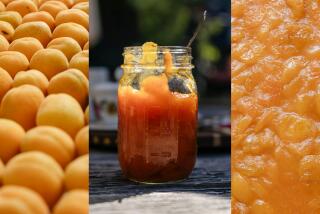The Unkindest ‘Cot
- Share via
Traditional apricots have faded away in the Winters area, but while recording their demise last June, I noticed a huge planting of unfamiliar apricot trees with narrower, pointier leaves.
It turned out I was just in time for the first harvest of America’s only commercial orchard of umes, or Japanese flowering apricots, planted by a Hawaiian investor named Ray Wong. When I sampled one of the small, green, slightly fuzzy fruits, however, its astringency puckered my mouth, and I spat it out.
At a nearby farm shed, Matthew Wong, Ray’s son, explained that umes are picked hard for processing, their only use. I watched him spray water and sprinkle coarse salt over big bins of umes. In a few weeks, Matthew explained, he would drain and wash the fermented fruits, set them out in the sun to dry and ship them to Honolulu for flavoring and coloring.
The resulting sweet and salty umes are one of many preserved fruits, known as “crack seed,” popular as snacks in Hawaii.
Native to China, ume trees are treasured for their fragrant blossoms in Japan, where the fruits are considered plums. Umes do look like little shriveled plums after the Japanese pickle and color them with red shiso leaves to make umeboshi, traditionally eaten with rice as a pickle; they are also used to make a liqueur, umeshu.
Top-quality umes fetch $90 a pound in Japan, and the best are rarely imported to America. But just last week the first shipment of the Wongs’ crack-seed umes arrived at Asian markets in the Southland, under the label Ume Farms of California.
Both of the flavors, “Light Honey” and “Li Hing Style,” tasted bracingly salty and sour to me at first, but I soon came to like the balanced intensity of the Li Hing.
More to Read
Eat your way across L.A.
Get our weekly Tasting Notes newsletter for reviews, news and more.
You may occasionally receive promotional content from the Los Angeles Times.










